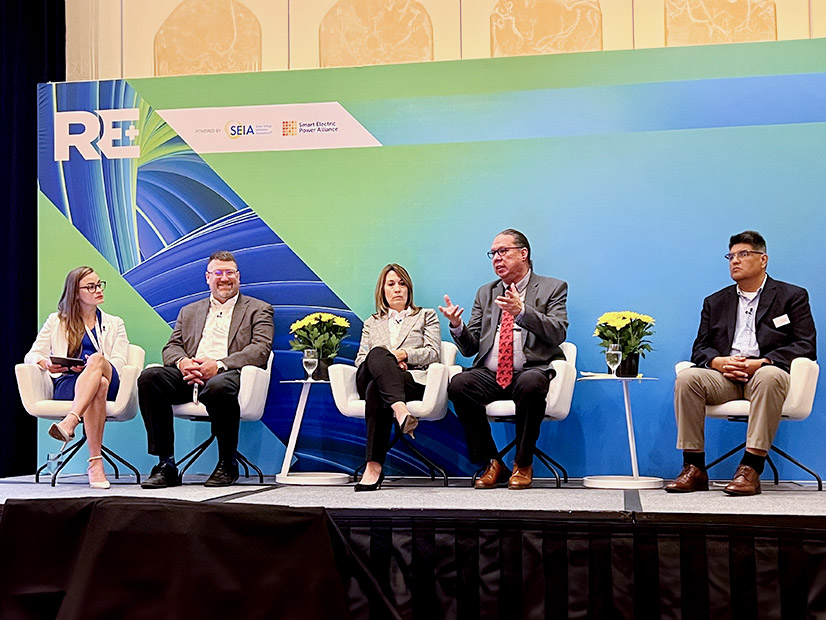
LAS VEGAS — The government and developers need innovative capital approaches and a commitment to building deep relationships to unlock the potential of clean energy development on tribal lands, experts said in a panel at this week’s RE+ conference held at the Venetian Expo and Caesars Forum.
However, the federal government is behind on outreach to tribal leaders about how to address financing and skill gaps, RTO Insider was told.
Tribal land accounts for 5.8% of the U.S. landmass but 6.5% of utility scale renewable energy generation potential, said Margaret Tallmadge, senior development manager at Navajo Power, a majority native-owned utility scale solar developer working with tribal nations and communities across the U.S.
Barriers to developing this “outsized potential” include “access to capital; limited opportunities to build technical capacity and internal capacity within tribes to pursue their own projects; and minimal knowledge of tribal sovereignty, federal Indian law and regulatory complexities in Indian country,” Tallmadge said.
Some of those barriers are exacerbated by the federal government, which is lagging in its trust responsibility to tribes, Paul Dearhouse, a senior consultant to the Tribal Energy Loan Guarantee Program at the U.S. Department of Energy’s Loan Programs Office (LPO), told RTO Insider. “We’re a few years behind in actually sending out a ‘Dear Tribal Leader’ letter, saying, ‘Here’s a program designed to finance tribal energy projects. What’s your thoughts? What’s your feedback? What are the best ways to do that?’ We haven’t done that to date.”
Tribal input is vital to develop appropriate ways of dealing with the unique challenges tribes may face, where they have land ideal for renewables development but little access to capital and often no experience working with developers whose incentives and financing structures are designed with short-term ownership rather than long-term land stewardship in mind.
Developers working with tribes also need to be innovative, balancing the need to craft project structures that enable the tribe to participate without a large capital outlay with financiers’ desire to have traditional PPAs, said Kevin Blaser, managing director of energy systems at Bakinaw Federal Contracting.
One example of where limited access to capital creates issues is with interconnection queues. While a pain point for most utility-scale development, they create an even larger challenge for projects on tribal lands, Dearhouse said. FERC orders and rules implemented at the RTO level to fix aging infrastructure can result in escalating fees to maintain a project’s position in the interconnection queue. Most tribes won’t have the large amount of capital needed to maintain their queue position, creating “a huge barrier,” but also an opportunity.
“This is a new frontier to make our LPO offerings better, to do a proper rulemaking for our program and to really listen to tribes that are in the queues across the nation, to ask: ‘Are there better ways that the Loan Programs Office could design the program to help address that specific gap?’” he said.
Developers Must Invest in Relationships
While funding mechanisms are important, developers seeking to build clean energy resources on tribal lands must start with building a relationship, Blaser said. “If you’re going to work or partner with tribes — and there’s a ton of benefits to doing that — you really have to take the time to learn their culture, learn what they’re trying to do, and understand what their strategy is, even if their strategy is ‘we don’t know.’”
There is no single right way of working with tribes, Blaser said: “Because there are 576 or so federally recognized tribes, there are 576 different ways of doing it. There are all those bodies of laws; every culture is different.”
A long-term perspective and partner mentality is essential as developers work with tribes, said Dave Harper, head of tribal engagement at the Alliance for Tribal Clean Energy. “You don’t want to be an outsider; you want to come in as a partner mentality. What does being a partner mean? It means that we’re going to be fair with each other, we’re going to be respectful. We’re going to be able to have dialogue and to sit down.”
Tribes need to use those partnerships when they have limited internal knowledge or bandwidth, Dearhouse said. “For utility-scale projects, many times a tribe has a part-time environmental coordinator, so they really have to bring in trusted partners like the fellow panelists here that can really help fill in that piece.”
A relationship with the LPO also is important for tribes seeking to deploy renewable projects on their lands. “We are long-term patient capital. The path that we walk to get a tribal applicant in the door through to funding can be long, months to even a couple of years, because of the steps that we take, but for a really responsive applicant, it can be expedited two months, but not every tribe’s ready.”



